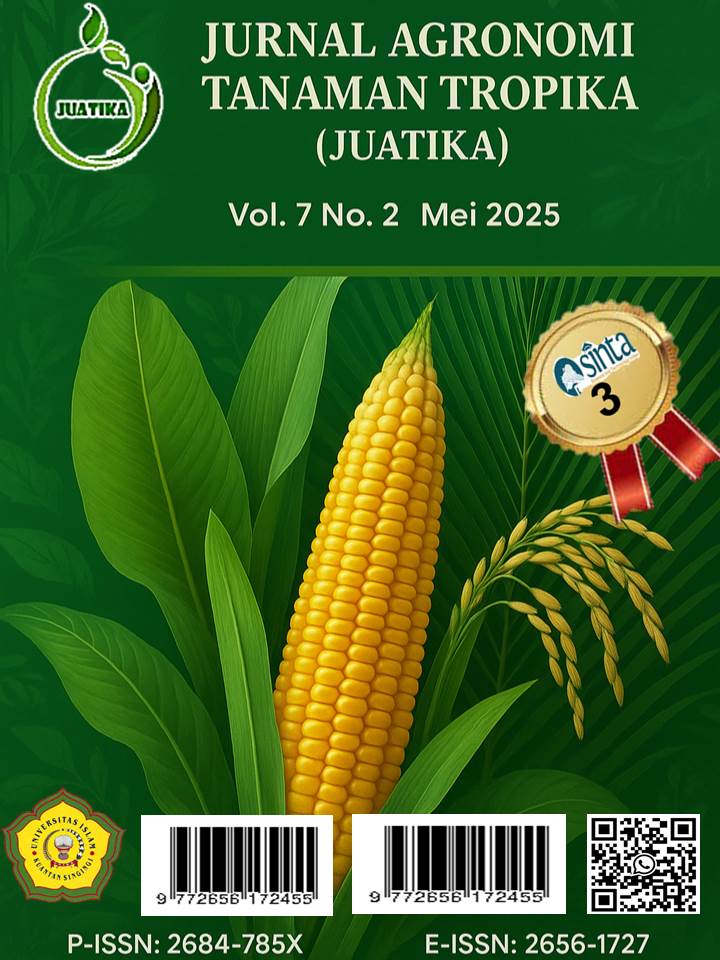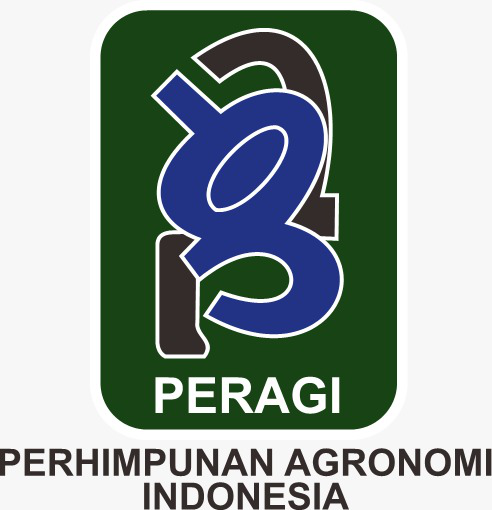Agronomic Appearance of Red Calliandra Plants (Calliandra calothyrsus) in Different Locations
Abstract
Red calliandra (Calliandra calothyrsus) is a leguminous tree native to Indonesia. This species can serve as a renewable alternative energy source to replace coal. Calliandra wood is highly flammable and can be utilized as biomass energy, offering a quality comparable to coal's. PT Semen Padang employs red calliandra as an alternative to coal in cement production, which results in lower carbon emissions. The company has planted calliandra in various locations throughout West Sumatra. This descriptive exploratory study employs a survey method to investigate the places where the plants grow, utilizing direct observation techniques. The three locations observed were behind the PT Semen Padang Training Center (Indarung, Lubuk Kilangan District, Padang City, West Sumatra), PT Semen Padang Mine (Indarung, Lubuk Kilangan District, Padang City, West Sumatra), and Sialangan (V Koto Timur District, Padang Pariaman Regency, West Sumatra). A total of 10 plants were sampled from each location, resulting in 30 plant samples overall. Subsequently, observations and data analysis were conducted. The characteristics observed included the morphology of stems, leaves, and flowers and a chemical analysis of the soil, which assessed pH, organic carbon, total nitrogen, total phosphorus, and total potassium. The results indicated that plant age, soil nutrient availability, and environmental conditions significantly influenced* the vegetative and generative growth of *Calliandra calothyrsus*. Locations with neutral soil pH and high phosphorus content supported greater stem diameter growth, while areas with elevated organic carbon and nitrogen levels promoted enhanced leaf development. Variations in the color of stems, leaves, and flowers were closely related to plant age, light intensity, and the availability of micronutrients. In conclusion, the agronomic differences in red *Calliandra* are determined by the interaction among plant age, soil nutrient status, and growing environment, all of which are critical factors for optimizing biomass production in the future.
Downloads
References
Andriani, R., Hesti, K., & Sriwulan. (2019). Inventarisasi tumbuhan pionir lahan bekas tambang kapur di Kecamatan Rengel Kabupaten Tuban Jawa Timur. BIOTROPIC: The Journal of Tropical Biology, 3(1), 56–61.
Barrett, S. C. H. (2002). The evolution of plant sexual diversity. Nature Reviews Genetics, 3(2), 274–284.
Chen, Q., Zhang, X., & Zhou, W. (2020). Influence of potassium nutrition on plant physiology and resistance to environmental stress. Frontiers in Plant Science, 11, 1240.
Kementerian Kehutanan. (2014). Budidaya kaliandra merah (Calliandra calothyrsus) untuk bahan baku sumber energi. IPB Press.
Marschner, H. (2012). Marschner’s mineral nutrition of higher plants (3rd ed.). Academic Press.
Mengel, K., & Kirkby, E. A. (2001). Principles of plant nutrition (5th ed.). Kluwer Academic Publishers.
Orwa, C., Kindt, A., Jamnadass, R., & Anthony, S. (2009). Agroforestree database: A tree reference and selection guide version 4.0. World Agroforestry Centre.
Poorter, H., Niinemets, Ü., Poorter, L., Wright, I. J., & Villar, R. (2009). Causes and consequences of variation in leaf mass per area (LMA): A meta-analysis. New Phytologist, 182(3), 565–588.
PT Semen Padang. (2023, December 6). Semen Padang tanam 2.000 kaliandra merah untuk substitusi batubara. Semenpadang.co.id.
Rahman, M., Fitriani, N., & Sukmawati, D. (2021). Adaptasi morfologi daun tanaman tropis terhadap faktor lingkungan. Jurnal Ilmu Pertanian Tropis, 6(1), 33–41.
Sarkar, R. K., Das, B. S., & Bhattacharya, A. (2017). Environmental regulation of flower morphology in tropical plants. Tropical Plant Biology, 10(2), 120–130.
Siregar, I. Z., & Ginting, A. N. (2018). Kajian morfologi dan adaptasi tanaman kaliandra merah (Calliandra calothyrsus). Jurnal Agroforestri Indonesia, 2(1), 12–20.
Stewart, J., Mulawarman, Roshetko, M. J., & Powell, M. H. (2001). Produksi dan pemanfaatan kaliandra merah (Calliandra calothyrsus). International Centre for Research in Agroforestry (ICRAF).
Sun, X., Zheng, S., & Zhang, S. (2020a). Effects of soil organic carbon on plant nutrient uptake and biomass production. Soil Science and Plant Nutrition, 66(1), 89–98.
Sun, X., Zheng, S., & Zhang, S. (2020b). Effects of soil organic carbon on plant nutrient uptake and biomass production. Soil Science and Plant Nutrition, 66(1), 89–98.
Taiz, L., Zeiger, E., Møller, I. M., & Murphy, A. (2015). Plant physiology and development (6th ed.). Sinauer Associates.
Valladares, F., & Niinemets, Ü. (2008). Shade tolerance, a key plant feature of complex nature and consequences. Annual Review of Ecology, Evolution, and Systematics, 39, 237–257.
Vance, C. P., Uhde-Stone, C., & Allan, D. L. (2020). Phosphorus acquisition and use: Critical plant adaptations for securing a nonrenewable resource. New Phytologist, 157(3), 423–447.
Widodo, W., Sutrisno, & Nugroho, J. T. (2017). Pengaruh faktor lingkungan terhadap pertumbuhan dan karakter morfologi tanaman. Jurnal Agroteknologi Tropika, 5(2), 85–92.
Yamori, W., Hikosaka, K., & Way, D. A. (2014). Temperature response of photosynthesis in C₃, C₄, and CAM plants: Temperature acclimation and adaptation. Photosynthesis Research, 119(1–2), 101–117.
Zhao, Y., Wang, P., Li, J., & Li, Y. (2021a). Soil pH regulates the availability of phosphorus and growth of crops in acid soils. Environmental Research and Public Health, 18(15), 78–96.
Zhao, Y., Wang, P., Li, J., & Li, Y. (2021b). Soil pH regulates the availability of phosphorus and growth of crops in acid soils. Environmental Research and Public Health, 18(15), 78–96.
Copyright (c) 2025 Arifatul Aulia Fikra, Benni Satria, Dini Hervani, Efderilla, Armansyah

This work is licensed under a Creative Commons Attribution 4.0 International License.
Authors who publish with Jurnal Agronomi Tanaman Tropika (JUATIKA) agree to the following terms:
Authors retain copyright and grant the Jurnal Agronomi Tanaman Tropika (JUATIKA) right of first publication with the work simultaneously licensed under a Creative Commons Attribution License (CC BY 4.0) that allows others to share (copy and redistribute the material in any medium or format) and adapt (remix, transform, and build upon the material for any purpose, even commercially) with an acknowledgment of the work's authorship and initial publication in Jurnal Agronomi Tanaman Tropika (JUATIKA).
Authors are able to enter into separate, additional contractual arrangements for the non-exclusive distribution of the journal's published version of the work (e.g., post it to an institutional repository or publish it in a book), with an acknowledgment of its initial publication in Jurnal Agronomi Tanaman Tropika (JUATIKA). Authors are permitted and encouraged to post their work online (e.g., in institutional repositories or on their website) prior to and during the submission process, as it can lead to productive exchanges, as well as earlier and greater citation of published work.







 More Information
More Information



